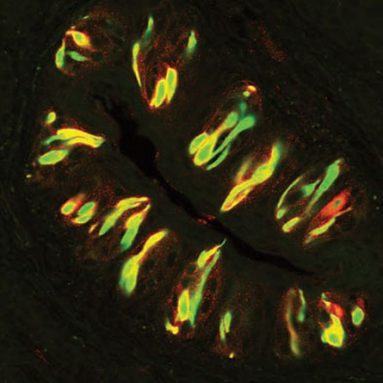The taste of bubbles
Taste cell for sourness senses fizz, too
 |
|
Studies with mice have shown how the same cells on the tongue that taste sourness also detect fizzy flavors.
|
| J. Chandrashekar et al./Science AAAS 2009 |
What does fizz taste like? In bubbly beverages like soda or champagne, tiny bubbles give the drink a lift — and have a distinct taste. Scientists have long wondered how we taste these bubbles. In a new study on mice, scientists have connected that fizzy-taste sensation to the ability to taste sourness.
Scientists previously thought the taste of bubbles comes from the bubbles bursting on the tongue — but that idea may have to change, says Charles Zuker. A neuroscientist, or a scientist who studies the brain and nervous system, Zuker is now at Columbia University in New York. He and his team of researchers studied the nervous systems of mice to understand how the tongue tastes carbon dioxide, which is the gas that makes up the bubbles.
In the experiment, five different groups of mice were genetically engineered to be missing one taste sensation. (“Genetically engineered” means the researchers were able to turn off the switches for certain tastes by altering the responsible genes.) The mice in one group were bred so that they could not taste sweet. In another group, the mice could not taste sour. In the other three groups, the mice could not taste umami, or salty or bitter.
When the scientists gave carbon dioxide gas to the mice, the nervous systems of the rodents in four groups responded to carbon dioxide. But for mice that could not taste sour, their nervous systems did not show any sign of tasting carbon dioxide.
This tipped off the researchers to the connection between sourness and bubbles. When the scientists turned off the sour taste in the mice genes, they also turned off the ability to taste carbon dioxide.
The scientists then zoomed in on the sour taste. Animals like mice or human beings are able to detect different tastes by using taste buds, located near the surface of the tongue. A taste bud is a group of 50 to 150 cells called taste receptors. (Under a microscope, this bundle of cells looks a little like a big bunch of bananas.) The tips of the taste receptor cells pick up tastes in the mouth, and then send that information to the brain.
When they studied the cells that detect sourness, Zuker and his colleagues found a protein, attached to the sour-sensing cells, that is crucial to the process of tasting carbon dioxide. When carbon dioxide comes into contact with this protein, the protein knocks off particles called protons. These protons, in turn, stimulate the sour cells.
So when a mouse — or person — drinks a fizzy drink, there’s a one-two punch. First, the protein knocks off protons. Second, the protons stimulate the sour-sensing cells —and the brain says, “Hey! That’s a taste!”
That may seem like a lot of work to get from a can of soda to a taste — but the science of the senses is anything but simple. Taste “is a very challenging system to study,” Alexander Bachmanov, a scientist at the Monell Chemical Senses Center in Philadelphia, told Science News. “Everything is very small but very complex.”
POWER WORDS (adapted from the Yahoo! Kids Dictionary)
nervous system The system of cells, tissues and organs that regulates the body’s responses to internal and external stimuli. In vertebrates it consists of the brain, spinal cord, nerves, ganglia and parts of the receptor and effector organs.
neuroscience Any of the sciences, such as neuroanatomy and neurobiology, that deal with the nervous system.
proteins Molecules that contain carbon, hydrogen, oxygen, nitrogen and usually sulfur. Proteins are fundamental components of all living cells and include many substances that are necessary for the proper functioning of an organism.
carbon dioxide A colorless, odorless, incombustible gas formed during respiration, combustion and organic decomposition and used in food refrigeration, carbonated beverages, inert atmospheres, fire extinguishers and aerosols.







